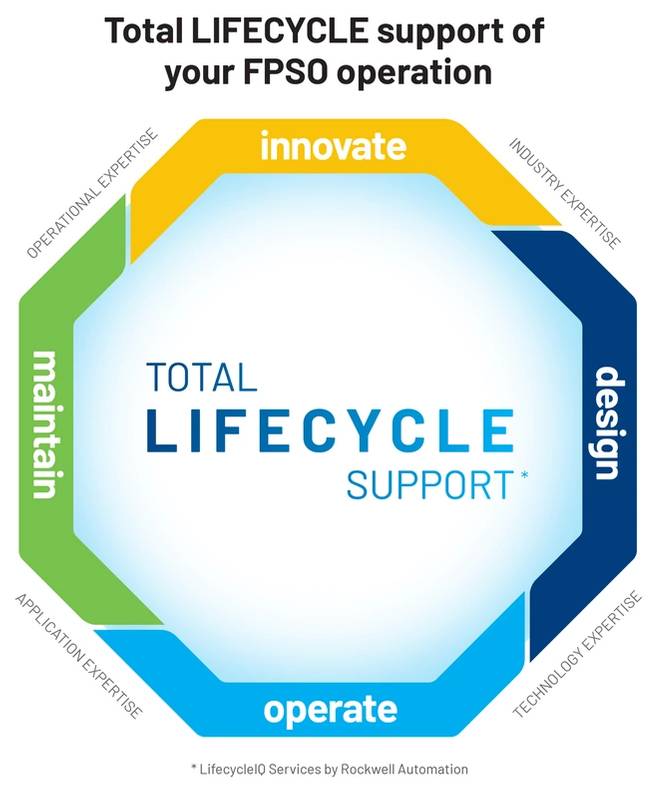How to Reduce Risk Across the Lifecycle of Floating Production Assets
Using digital transformation to mitigate risks and increase performance of offshore rigs
Floating production storage and offload vessels (FPSOs) are among the largest investment trade-offs an oil and gas producer will make. On the one hand, these immense vessels offer the promise of exponentially increased production and storage flexibility over onshore counterparts. On the other, they come with a colossal price tag in terms of equipment, operations and maintenance.
According to a survey by McKinsey, projects in heavy industry sectors overrun their budgets and schedules by 30% to 45% on average. The average engineering, procurement and construction (EPC) project fares even worse throughout the industry. Production is yet another challenge. Due to suboptimal operations, unplanned downtime and operational incidents, according to Rystad Energy, the upstream part of the industry experiences approximately $500 billion per year in deferred revenue globally. However, despite these industry statistics, the more successful FPSO operators are achieving better than 99% uptime and, in some cases, very close to 100%. But how can companies operating at these high levels of productivity, embrace digital technologies to maintain and even optimize their existing operations?
For those producers embarking on new floating production facility journeys or looking to upgrade existing ones, it’s time to shift gears and redirect the trajectory. A floating production vessel might be disconnected physically from land, but it can still take full advantage of the latest developments in digital technologies and work processes. This article shares insight on a new end-to-end connected strategy that enables producers to proactively mitigate risks and extract more value at every stage of their floating vessel’s lifecycle.
Floating production-facility challenges
Before we drill into how to digitalize, let’s take a closer look at the major challenges weighing down the operational effectiveness of FPSOs.
Reliability and management of key production assets continue to be an area of critical focus – unplanned maintenance on a floating production facility costs an estimated 100 times the amount of the onshore equivalent. Assets are operated to production limits. Maintenance equipment and expertise are often lacking onboard, which necessitates the high costs and inconvenience of transporting equipment and personnel to remote locations. Plus, the turnover rate for operations staff is higher than average. New personnel must be trained specialists with qualified experience to be effective and follow crucial safety measures. All these issues negatively impact equipment life and increase operations and maintenance costs.
Meanwhile, Health, Safety, Security and Environment (HSSE) is another major challenge. An overriding and undeniable goal of the industry is to decrease and eliminate incidents, whether they’re related to safety, spills (hydrocarbon containment), cyber security or something else.
For example, the number of ransomware incidents involving the manufacturing sector increased 156% between the first quarters of 2019 and 2020. In addition, recently several manufacturing organizations were targeted with cybersecurity threats, including one of the largest U.S. pipeline operators, Colonial Pipeline. In May, the operator shut down 5,500 miles of pipeline, which carries 45% of the East Coast’s fuel supplies, to contain a ransomware breach.
To help with these challenges, oil and gas companies need to implement industry-proven standards such as NIST and ISO/IEC 27032 across their enterprise to manage their assets through continuous monitoring and lifecycle management. Oil and gas producers are also pushing to minimize the number of staff in the production environment and improve overall physical safety conditions. And finally, all operating oil and gas companies are committed to achieving full regulatory and environmental compliance as part of their social responsibility goals, including drastically reducing hydrocarbon releases.
 Source: Rockwell Automation
Source: Rockwell Automation
Enabling Digital Transformation
Together, these major challenges have dramatically affected the effectiveness of major offshore projects. However, by creating a “connected vessel,” especially with a third party that can help design and deploy the entire strategy, producers can mitigate these and other risks, and set a course to reduce total cost of ownership through effective initial project execution to First Oil Date and achieve long-term operational efficiency.
Based on a fully digitized approach, the connected vessel benefits each phase of the project and operations. Unifying the digital strategies and content leveraged across the organization is key. This “digital thread” starts during design and flows through the full production lifecycle of the facility. The cohesive digital plan takes total advantage of digital enablement in system design, while setting the stage for proper commissioning and smooth start up, optimized ongoing operations and maximized performance.
Through digital transformation, producers can save in total cost of ownership through effective initial project execution and long-term operational efficiency, because:
- A streamlined scope reduces capital costs
- Project schedule improvements reduce project costs
- Improved operations via availability, reliability, and maintainability increase production and overall operational equipment effectiveness
The result? The use of the connected vessel execution methodologies and technologies lead to a potential savings of $150 million per floating production project. Not to mention the life-time benefits.
So, why not take measures to control what you can? By making the investment to build and operate a connected vessel, producers can effectively reduce risks, drive efficiency, optimize performance and realize the true potential of their assets.
Connecting the Vessel
This end-to-end strategy takes an innovative design and implementation approach to building and managing floating production facilities to address the automation, electrical and measurement project scope. It also addresses the entire process – from the reservoir through topsides production, and beyond – including:
- Reservoir production, sea floor operations management and well flow
- Power management systems, including switchgear and motor controls
- Hull and marine applications that include bridge management
- Process and safety production systems
- Management of the topsides production modules as well as the subsea modules
- Networking and connectivity to on-board and remote operations center(s)
Bringing a connected vessel to fruition centers around the following main areas of development:
Project Execution
In any project, major automation and electrical systems become the critical path to project completion and long-term operational performance. Without proper design and implementation, ensuing changes cause delays and add expense in the near and long terms. Poor execution also results in costly changes at the shipyard, causing delays in commissioning and start up.
While automation and control systems are a fraction of the overall project budget, the coordination of master and module systems is critical to the success of the project and success in operations. Producers need efficient, integrated systems they can rely on that are digitally enabled, all of which a connected vessel provides.
Production and Operations
A lack of visibility into and understanding of the reservoir and well-flow conditions often cause poor performance. Energy producers need confidence in the accuracy of fiscal metering. Measurement of flow is a mission-critical component of the operations; knowing exactly what is flowing into and out of the vessel can be the difference in a project’s commercial success and compliance with national regulations. As such, in a connected vessel, production modules are designed and supplied to the shipyard with consistency and standardization. They can be operated using advanced technologies to implement asset management and remote support, along with obsolescence and spare-parts management. Furthermore, a connected vessel enables data-driven reliability, availability targets and critical asset-maintenance strategies to bolster operational equipment effectiveness.
To address production and the operational life of the vessel, the latest technologies are deployed to ensure maximum production, visibility and flow assurance from the reservoir through the production units. Plus, reservoir analysis and management maximize production over the life of the facility. Such benefits are well documented and result in improvements in project and operating costs, production rates and recovery rates.
Meanwhile, with this approach, the offshore facility is virtually connected to an onshore operations center to deliver the objectives of a fully digitalized project. This provides a central location for coordinated operations for the life of the vessel and enhances access to subject matter experts – within the operating company and externally – to supply asset and process experts.
HSSE
The nature of floating production projects in extremely isolated locations requires that all efforts are made, and all viable technologies are deployed, to minimize the number of people required onboard and their transportation to and from the production vessel. Although rigorous safety protocols are put in place, actively monitored, and effectively followed, there is always inherent risk that can impact personnel, equipment and the environment.
To address both operations and HSSE issues directly, the latest technologies and workflows are used to remotely connect operations personnel to information and expertise in real time. This also allows the training and implementation of a fully connected operator via multiple tools and technologies to other team members onboard or onshore, to knowledge bases on the production vessel and to remote subject matter experts anywhere and anytime, as needed.
Furthermore, the implementation of a fully connected remote operations center makes it possible to minimize the need for staff onboard the vessel, while giving them greater access to information and expertise. So, operations team competency and performance increases, and allows for renewed analysis of optimal team size. This ultimately helps reduce manpower on the vessel, which reduces risk and lowers the cost of transportation and other operating expenses.
Looking Ahead
Already 20% to 30% of oil and gas production comes from offshore facilities, with more producers looking to procure new FPSOs worth billions of dollars just to build and even more to operate. By embarking on a connected digital strategy that anticipates and addresses the many significant and costly challenges of project execution, production, operations and HSSE, producers can be far more confident and better equipped for long-term success. To get there, working with a trusted third-party partner that can provide end-to-end strategic support streamlines project management and execution, design, and implementation, and provides continuity from construction or conversion through the entire lifecycle of the vessel.







